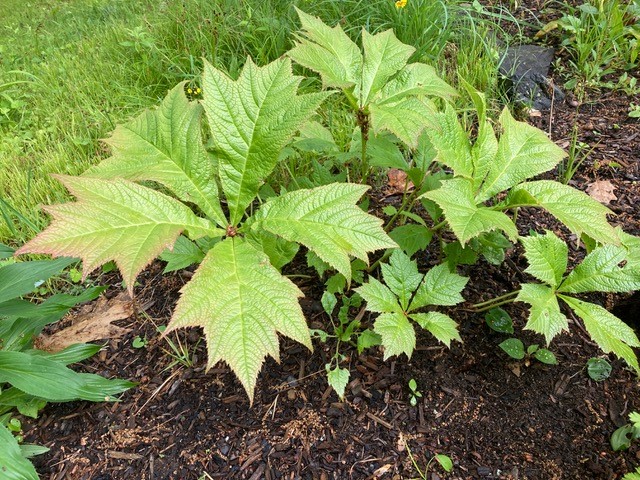Many people think that ornamental gardens are all about the flowers. The truth is, flowers are fleeting, showing up when it’s time for them to bloom, lasting a few weeks at most and then dropping petal by petal to the soil.
Those are the good years, when high winds or heavy rains don’t knock down the blossoms, sometimes stems and all, before they reach peak bloom.
So it’s a good idea to grow some plants just for their leaves. While all plants have leaves – technically, evergreen needles are simply a special form of leaves – some have large, colorful and/or distinctively shaped leaves that stand out in the garden. Take it from me: You’ll want to add several of those to your space.
One perennial that every garden should have – especially gardens with more shade than is ideal – is Rodgersia. My wife Nancy and I have have several in our garden. The plant does produce flowers, but its prime attribute is the leaves, which are attractively quilted and as much as 12 inches across. In some varieties the leaves are deep green, and in others they are bronze or even deep red. The stems can get to be 3 to 4 feet tall, so the plants are absolute stunners. Rodgersia like a lot of moisture – and are recommended for growing next to bogs. One variety, R. Podophylla, can take full sun if it has enough moisture; R. aesculifolia and R. Henrici need at least part shade and can handle full shade.

Mullein growing in Tom and Nancy Atwell’s garden. They didn’t plant it; it just showed up one year, but they like it for its large, showy leaves. Photo by Tom Atwell
We didn’t even plant the specimen that persuaded me to write this column. It just showed up in our garden in two separate spots, well away from each other. After doing some research, I discovered they are mullein, with the botanical name Verbascum. It is sometimes considered a weed and will show up in bogs and ditches alongside the road, but it isn’t on the list of plants the state is considering banning as invasive. Local nurseries sometimes sell it.
The different varieties are described as either biennials (plants that produce leaves the first year, flowers the second, and then die) or short-lived perennials – in other words, they will keep coming back but don’t be surprised if they die. Mullein have silvery and fuzzy leaves, and the flower stalks, which come in mid- to late summer, rise 3 to 4 feet above the foliage. They love poor soil. One of ours is growing in the gravel between our driveway and a perennial bed, and the other is near a path toward our garden shed.
Ligularia is another big-leaved plant, and it’s a true garden-statement plant. Depending on the variety, it will do well in full sun to full shade, but most prefer sites that are at least partly shady. The leaves, which are often serrated, can be more than an entire foot across. They are round to heart-shaped and come in a range of colors that include dark green, red, maroon and almost black. One variety, called ‘King Kong,’ has purple leaves that can grow to 42 inches wide. As a bonus, in the summer, Ligularia produces tall stems of typically daisy-shaped flowers.
Brunnera provides mounds of large, silvery leaves that really stand out in the shady areas where it grows best. It is sometimes called perennial forget-me-not because the two blossoms look similar, although the plants themselves do not. The plant spreads by its roots, and over time it can become an effective ground cover. If that is not what you want, Brunnera is easy to dig and divide.
My next two suggestions are common plants, but still highly attractive. Hostas are everywhere, and are the first plant many people think of for shady places. They are also among deer’s favorite foods, so that can be a problem.
Be sure to buy with care, though, as there are also small leaved hosta, too – it’s a huge family. Hostas come in green, blue, variegated, gold and even white. They produce flowers of varied colors late in the season, but the flowers are sort of a side benefit. ‘Big Daddy’ is a popular large-leaved blue hosta, and ‘Jurassic Park’ is a green-leaved variety with 17-inch leaves.
Everybody knows about rhubarb, but it’s usually relegated to a spot near the vegetable garden. While the stem makes delicious pies and cakes, don’t forget it can also be a gorgeous, big-leaved statement plant in your perennial border.
When I did a Google search for big-leaved plants to make sure I hadn’t missed any obvious ones, I was pleased but a little surprised to see mayapple listed. The plant appeared in a shady section of our backyard garden this spring, and neither Nancy nor I remember planting it. The leaves are 6 to 8 inches across, but they seem larger because the plant is less than a foot tall. Because the white blossom appears below the leaves, it’s usually at least partially hidden. It’s gorgeous, but you have to get down on you knees and look for it.
When I posted a photo of our mayapple on Facebook, others piped up to let me know that all parts of the plant are poisonous, except for the fruit when it is totally ripe. I won’t take a chance. I’ll just look at our mayapple and wonder how it got there.
Tom Atwell is a freelance writer gardening in Cape Elizabeth. He can be contacted at: tomatwell@me.com.
Send questions/comments to the editors.



Comments are no longer available on this story